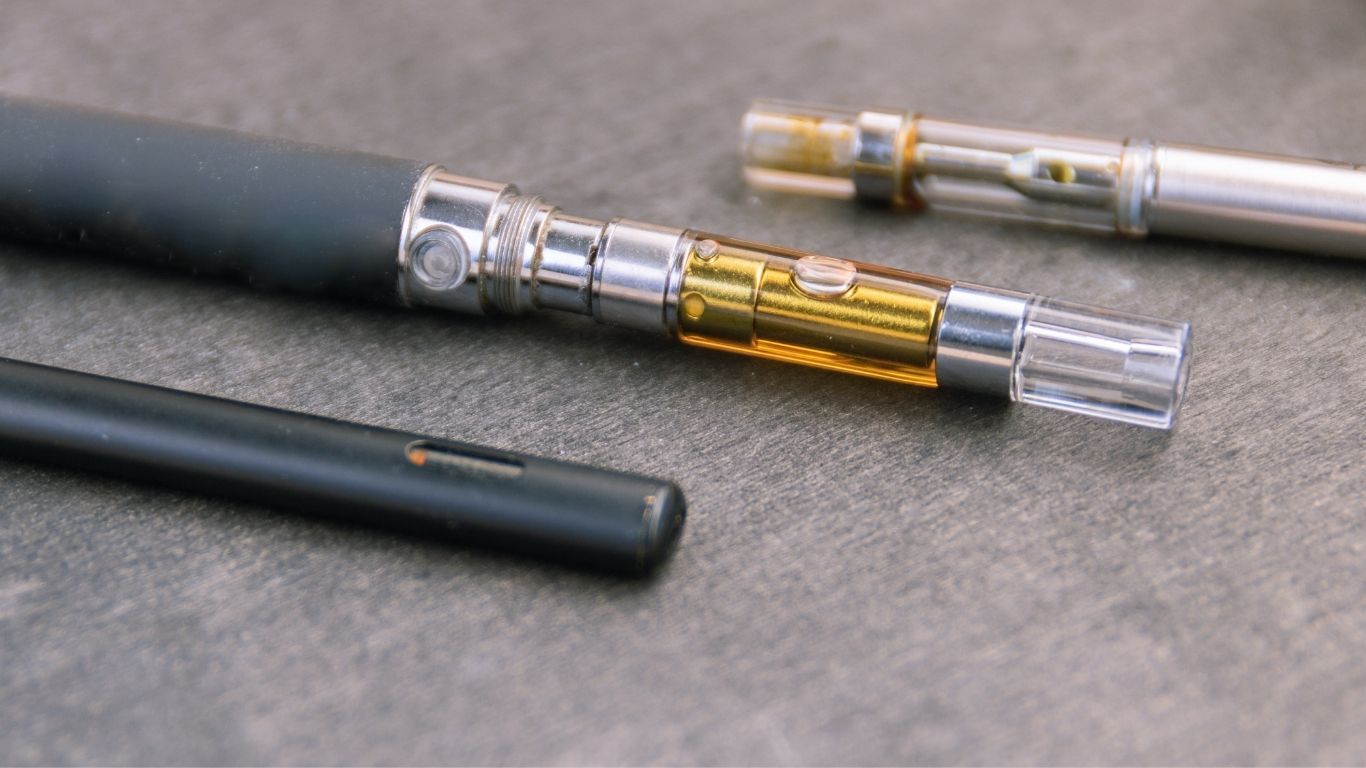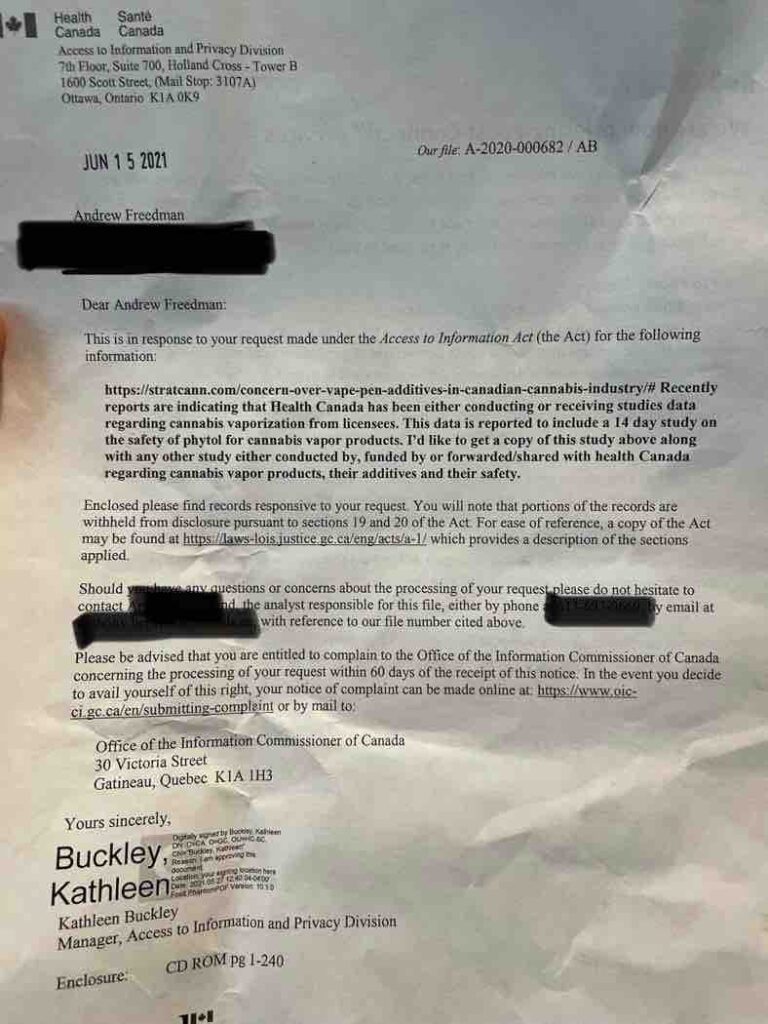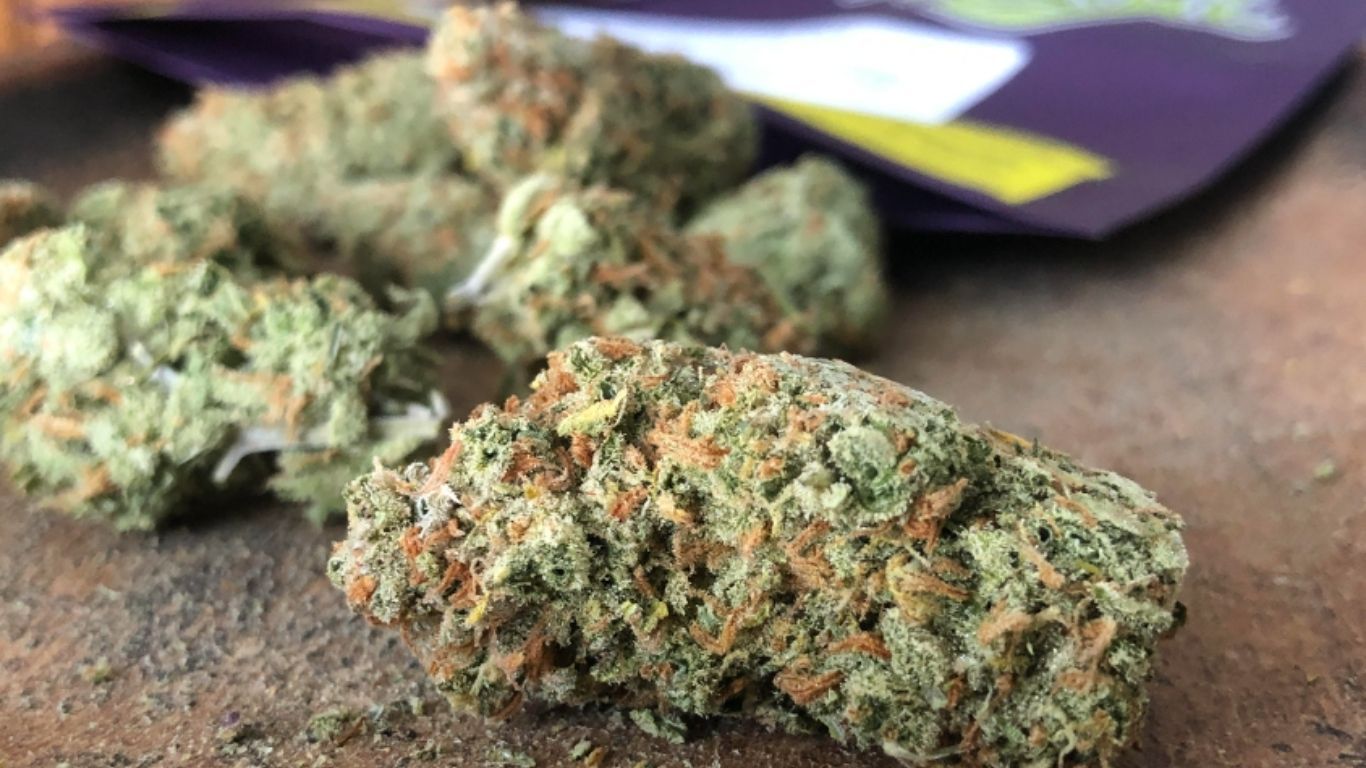
A study released in late 2020 says that phytol, an ingredient used in some cannabis vape pen formulations, causes severe pulmonary injury and even death after inhalation dosing in rats.
A new, in-depth report released by Leafly has highlighted the 2020 safety study of phytol, commissioned by Canopy Growth.
The report shows phytol has numerous potential health concerns as an additive in vape pens, based on a study showing certain levels of phytol inhalation hurt lung tissue in lab rats. This was juxtaposed with the study showing a lack of similar harms from propylene glycol, which many in the industry have seen as an unhealthy additive.
The issue was first reported by StratCann in August 2020 when Tokyo Smoke began removing vape pens from their shelves that contained phytol.
At the time, Tokyo Smoke’s Vice President of Operations in Ontario sent an email to vape pen manufacturers, dated July 31, noting that the cannabis retail chain’s Ontario operations said they were giving companies 48 hours to respond to the request or face a stop-sale order on the company’s vape carts and filled pens. The stop order would be in place until the manufacturers can provide written confirmation that their products do not contain the additive phytol.
Canopy Growth acquired Tokyo Smoke’s parent company Hiku in 2018.
The email stated that Tokyo Smoke’s concern is associated with a 14-day inhalation toxicology study to be published “in the coming weeks”, that Canopy Growth Corporation has shared with Health Canada. It also states that in their letter to Health Canada, Canopy will be placing immediate stop-orders on any vape products that list phytol as an ingredient and that the company will be following up with any vape pen manufacturers who list “terpenes” as an ingredient to determine if the terpene phytol is used.
One person who helped bring the study to light, David Heldreth, of Seattle, worked with Canadian Andrew Freedman to file an AIA request to get the full study released.
“I think there’s lots and lots of other terpenes and other compounds that are in cannabis that probably shouldn’t be inhaled.”
David Heldreth, CEO of Ziese Farms and Panacea Plant Sciences
Heldreth and Freedman say they became aware of the study after reading the initial StratCann article and from talking to others in the industry. Heldreth’s interest was stoked by the fact he had previously worked as the Chief Science Officer at True Terpenes, a company in Southern California that supplies terpenes and other formulations for the cannabis industry for use in things like vape pens. True Terpenes still lists phytol as one of their products.
Heldreth is currently CEO of Ziese Farms, a hemp foods company in Washington State and Panacea Plant Sciences, a consulting and research agency. He’s also working in psychedelics with a handful of researchers in Canada.
He says he wanted to see the full study, around 250 pages, rather than the short release put out by Canopy. But ultimately even what Health Canada provided from the AIA to him and Freedman was so heavily redacted that it contained the same basic info.
Freedman, a consultant in the cannabis industry who recently published a book entitled “Terpenes For Well Being”, says he first started to have concerns when he couldn’t get information from cannabis vape manufacturers as to their ingredients.
“I was involved in opening some retail stores last year, during the summer, and none of the representatives wanted to disclose to me their certificate of analysis to show the full botanical terpene blend that was coming in any of the vape carts. So David (Heldreth) and I started having a discussion.
“He was very much on the trail of phytol and looking into his beliefs that it was a dangerous additive. So I started poking around and asking the question of why nobody wanted to release it. Then there was the StratCann report that David saw and he basically asked if I would file the request and showed me how to do it.”

Phytol is sometimes used as a thinning agent in vape pens. The cannabis oil used in vape pens requires a thinning agent to ensure it is fluid enough to be effective with a pen’s heating coils. Pure cannabis oil would be too thick to properly heat and inhale.
Leafly’s report notes that Heldreth had become “increasingly alarmed” when the medical journal Inhalation Toxicology published findings showing phytol was more harmful than propylene glycol. “Phytol, not propylene glycol, causes severe pulmonary injury…,” the study reported.
While phytol is present in cannabis, it’s only found in minimal amounts as part of the breakdown process of fresh plant matter. The belief that all terpenes and other byproducts like phtyol are safe because they are “natural” is a fallacy, says Heldreth.
“I think there’s lots and lots of other terpenes and other compounds that are in cannabis that probably shouldn’t be inhaled. Phytol is a degradant, which isn’t really formed by cannabis, it’s a breakdown component found in small amounts. So it’s not really produced by the plant, it’s a breakdown of chlorophyll.”
“When we look at botanical terpenes put into things we vaporize, as they’re being stripped down and distilled into these single source molecules, these are the exact same thing that we’re putting into cleaning products. Limonene is found in almost every singe cleaning product as a commercial cleaning agent because it’s such a miraculous solvent that also smells great.”
Andrew Freedman, author of Author of “Terpenes For Well Being”
The amounts being used in vape pen formulations, he says, it’s a much higher concentration than anyone would inhale when smoking cannabis flower. While the study used a concentration in the air of .0005% phytol, he says the amount one is getting from a vape pen is even higher and might be over a longer duration long term depending on how much is consumed over time.
“If you’re a vape pen and you’re hitting it for, you know, ten seconds, and you do that six times, that’s a minute,” says Heldreth. “So if you hit your vape pen thirty times in a day, you might get close to that thirty-minute exposure. So however many times you hit that through the day is your exposure time. So how many seconds or minutes a day are you hitting the vape pen.
“The amounts of phytol that are in some vape diluents, are up to 10% volume. There was .0005% that killed things (in the study). So it’s a longer exposure time, but you’re actually being exposed to more of it through vaping than in this study.
For his part, Freedman says he agrees there are many concerns with an array of terpenes, especially when it comes to inhalation. The product itself amounts to a massive experimentation in inhalation of specific formulations really never seen before.
While humans have been smoking cannabis for a long time, the inhalation of concentrated cannabis extracts and the addition of terpenes for flavour or formulation is entirely new, he says.
“If you were to put menthol or cinnamon essential oil on your skin it will burn you and hurt you. If you put it in your eyes it can blind you. Vaporizing anything above about 8% terpenes, that’s a caustic level. What does exposure to caustic levels to things we use as solvents and cleaning products end up doing to us over a long term? Well, we’re finding out right now.”
“When we look at botanical terpenes put into things we vaporize, as they’re being stripped down and distilled into these single-source molecules, these are the exact same thing that we’re putting into cleaning products. Limonene is found in almost every single cleaning product as a commercial cleaning agent because it’s such a miraculous solvent that also smells great.”
Health Canada looking to restrict vape formulations
Health Canada also appears to be looking at the issue on their end. In addition to their draft regulations released earlier this year that would put new limits on what types of flavours can be used in vape pens, in mid-July 2020, Health Canada also sent out a request to licence holders selling cannabis vape pens to provide additional information on the “composition of certain vaping products which may be used to determine if products contain substances that are prohibited or that may be injurious to health”.
“More specifically,” states the letter from Health Canada, “it is requested that you respond with the following information: The composition of the product (i.e. the full list of individual ingredients, and the net weight, net volume or concentration by weight or volume of each of those individual ingredients); The supplier or manufacturer of each of those ingredients; For each ingredient, identify whether it is a (a) carrier substance, (b) flavouring agent, or (c) necessary to maintain the quality or stability of the cannabis product; If applicable, the composition of each ingredient (e.g., for a flavouring agent, the list of substances in that flavouring agent, and the net weight, net volume or concentration by weight or volume of each of those substances)”.
Earlier this year, Health Canada announced their proposed regulatory changes that would further restrict the use of flavours not associated with cannabis.
Traditionally, vape manufacturers have used thinning agents propylene glycol, polyethylene glycol, vegetable glycerin, or medium-chain triglycerides (MCT), generally from coconut oil. But as increasing health concerns have been associated with heating and inhaling those products, manufacturers have moved to other thinning agents, often using terpenes, either sourced from cannabis, other botanical sources, or synthesized.
Many consumers have come to see terpenes as being more “natural” because they can be found in cannabis and other plant-based products. However, heating and then inhaling large concentrations of these volatile organic compounds have many known, and potentially many more unknown, health risks.
Terpenes can be used both as a thinning agent as well as flavouring. Terpenes are generally either cannabis-derived, or botanically derived from other plants.
In 2019, a major public health scare associated with cannabis vape pens from the black market was associated with an increase in lung infections, primarily in the US, which many researchers were connecting to thinning agents being used in these products.
Although there has been no definitive evidence of the specific culprit, many have pointed to thinning agents like Vitamin E acetate. Some have also pointed to terpenes being used as a thinning agent as a potential culprit. Phytol is an acyclic diterpene alcohol that can be used as a precursor for the manufacture of synthetic forms of vitamin E.
Researchers in Oregon last year identified pine resin as a potential culprit, as well.
Canada opened up the market to cannabis vape pens in October 2019, with products appearing on the shelves beginning in late 2019 and early 2020. Producers are not currently required to list ingredients for vape pens other than cannabis.
There are currently no products listed on any provincial cannabis websites listing phytol as an ingredient. One company, Dosist, listed its ingredients last year as Cannabis extract, beta-Caryophyllene, Farnesene, Linalol, alpha Humulenem and Limonene, but no phytol.
Some cannabis vape pens simply list their ingredients as “cannabis extract”, “THC Distillate”, or “Full-spectrum cannabis oil (including terpenes)”. Some also list specific terpenes, or just the presence of terpenes.
In response to a request for comment from StratCann to dosist in 2020 on the issue of the letter from Health Canada, and what products, if any, dosist only said they had no additional information to provide and would be following Health Canada on any updates regarding regulations.
A request for comment from dosist was made at the time of publication. This article will be updated with any response from Dosist.














